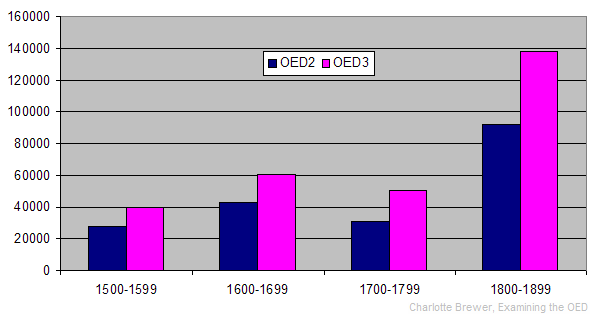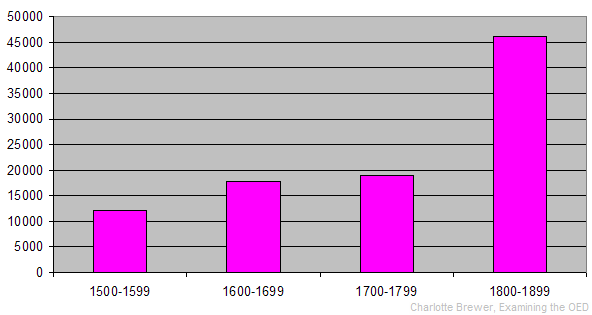To get an outline view of
OED3's practice on quotation citation over the years 1500-1899, we need to do the same as with
1150-1499: isolate the portion of the alphabet range which has been revised, and compare the number of quotations in
OED2 and
OED3 for this stretch of the alphabet only.
Our project has collected data at different points in time, as illustrated in the graphs and table below. What these show is that different periods of the language (e.g. the sixteenth and eighteenth centuries) have been more, or less, intensively cited at different points in the revision process. It's not entirely clear why this should be so; one possible explanation is that more eighteenth-century sources, for example, have been cited since the online database
Eighteenth Century Collections Online became available (March 2004).
The implication of these findings is that, as in previous versions of the Dictionary, the results recorded in the
OED tell us not only about the English language itself, but also about the resources available to the lexicographers and the ways they have made use of them. However, a major difference between
OED3 and its predecessors is that continuous revision is now possible. If it turns out that certain periods, or sources, have been over-cited or under-cited, the lexicographers can return to their previous draft of
OED3 and rewrite it in these respects.
You can go straight to our conclusions
here or review the presentation of evidence more gradually by reading steadily through the page.
Outline pictureDecisions about how to represent and analyse the data obtainable from electronic searches of the
OED are not straightforward. Graph 1 below seems to show that, in broad outline,
OED3 (the pink line) is tracking the same pattern of accumulation of quotations over 1500-1899 as
OED2 (the navy line): note the late-sixteenth-century rise – slightly moved, reflecting re-dating of Shakespeare's texts; and the eighteenth-century dip. However, since
OED3 includes almost all of
OED2's existing quotations, it is hard to see whether the current revision is repeating an existing pattern or to some extent 'correcting' it. (The graph is based on electronic searches made December 2005-January 2006, counting quotations per decade in
OED2 and
OED3.)
Graph 1: OED2 and OED3 quotations per decade 1500-1899 (M-philandering)

The next graph (no. 2 below) represents the same data differently, to reveal that
OED3 has collected strikingly different quantities of quotations for each century. The most favoured period for quotation citation is the nineteenth century. This was also true for the first edition of the
OED (see our page on
OED1's treatment of the
19th century in
Period coverage). Why should this be so? Presumably because words current in the nineteenth century include
both many of those already in existence in previous centuries
and a good number of new coinages, or new senses of existing words. Our data on
FQ% by century in
OED2 indicate that the
proportion of 'First quotations' - i.e. new words - relative to total quotations in the nineteenth century is in fact lower than for other centuries, so this would suggest that the preponderance of nineteenth-century quotations in
OED2, if not
OED3, is due more to continuing currency of existing words than to coinages.
It may also be the case that nineteenth-century quotations were and are easier to find than ones from earlier centuries, and that the lexicographers have tended to cite more heavily from this period than for others. We could only test whether this partially explains the high numbers of nineteenth-century quotations if we were able to count the number of quotations per century which the lexicographers have cited per word or sense, something which is not at present possible.
Graph 2: OED2 and OED3 quotations per century 1500-1899 (M-philandering)
 Detail
Detail
The point is made more clearly by looking at the new quotations on their own over the same stretch of alphabet (i.e. the revision from March 2000 to December 2005), as in graph 3 below:
Graph 3: New OED3 quotations per century 1500-1899 (M-philandering)
 It turns out
It turns out, though, that the lexicographers have concentrated more on some periods of the language for some parts of the alphabet, and other periods for other parts of the alphabet. Between December 2004 and December 2005, for example, while revising the alphabet range
ovest-philandering, they cited more eighteenth-century sources than sixteenth-century ones (while continuing to cite ones from the nineteenth century most of all).
Here (graph 4) we see what they had done between
M and
overzealousness (i.e. March 2000-December 2004):
Graph 4: New OED3 quotations per century 1500-1899 (M-overzealousness)

And here (graph 5), what they did between
ovest and
philandering (i.e. December 2004-December 2005):
Graph 5: New OED3 quotations per century 1500-1899 (ovest-philandering)

The differences between graphs 4 and 5 clearly indicate that the lexicographers have been giving more attention to eighteenth-century sources in the recent stages of their revision than hitherto. For an account of the first edition's treatment of this period, see our page on the
18th century under
Period coverage.
Finally, the pie charts below compare
OED2 and
OED3 PERCENTAGES of quotations for 1500-1899 over the revised alphabet range
M-philandering (i.e. the
OED3 revision up to December 2005):
OED2 total quotations 1500-1899 (whole dictionary)

OED3 NEW quotations 1500-1899

OED3 quotations 1500-1899 (M-philandering)
This data is summarized in the following table:
OED2 and OED3 percentages of quotations 1500-1899 (M-philandering)
Century
| OED2 total quotations
| OED3 new quotations
| OED3 total quotations
|
M-nipissing (September 2003)
| nipissing-overzealousness (December 2004)
| overzealousness-philandering (December 2005)
| M-philandering
|
16th
| 15
| 13
| 14
| 10
| 14
| 14
|
17th
| 22
| 18
| 19
| 20
| 21
| 21
|
18th
| 16
| 19
| 19
| 25
| 18
| 17
|
19th
| 47
| 50
| 48
| 45
| 47
| 48
|
The most striking revelation here is the continued dominance of nineteenth-century quotations in both
OED2 and
OED3.
But the change in relative documentation of the sixteenth and eighteenth centuries also looks significant. Between December 2004 and December 2005,
OED3 has substantially increased its
relative collection of eighteenth-century quotations, and brought it up to 25% (at the expense, apparently, of sixteenth-century quotation collection). If this recent trend continues, then the proportions of quotations per century in the
OED may look very different in the next few years.